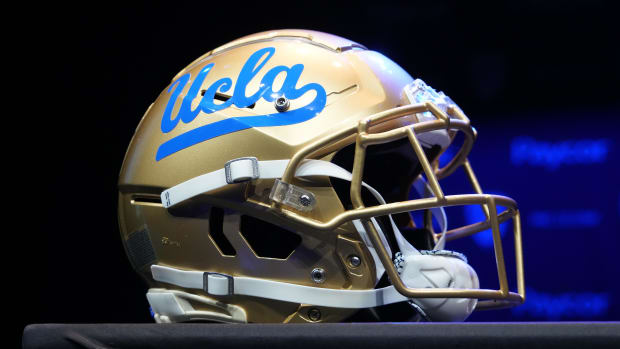Texas, Oklahoma and the SEC Expansion Talk That Could Reshape College Sports
During a conversation in May, one of the people I respect and trust most in college athletics dropped this on me, unsolicited: “Keep an eye on Texas and Oklahoma.” The person suspected that the two traditional power programs in the Big 12 were again getting the wandering eye, a decade after nearly leaving that league in ruins and radically changing the national landscape.
Later in May, it was reported that the Big 12 made early efforts to lock up a new media rights deal with broadcast partners ESPN and Fox, four years ahead of its expiration. Those efforts were rebuffed by the networks, according to the Lubbock Avalanche-Journal, signaling a lack of interest in paying bigger money to the Big 12. That was another indicator of the league’s fragility.
I asked around with several other parties in college athletics, but nothing firm materialized. Now fast forward two months, and there is some reported fire to go with all that smoke. The Houston Chronicle published a story saying that the Longhorns and Sooners have approached the Southeastern Conference about jumping aboard. Not only that, but a decision on their potential addition to the SEC could come in mere weeks.
If you’re looking for the lever that could flip college athletics irrevocably in the direction of a new model and new shape, this would qualify. Everything could be on the table, from the long-theorized four Super Leagues to a power-conference breakaway from the NCAA. This could massively alter the entire enterprise, at a time when upheaval already is underway and the NCAA has never had less authority.
(Or it could lead to nothing. Texas and Oklahoma have been known to find their way to the brink before backing down. The Pac-12 almost had them back in 2011, and they also batted their eyes in all other Power 5 directions.)
Interestingly, reaction in both the Big 12 and SEC Wednesday was fast but not furious. The word “speculation” was thrown around by several people, but there were a grand total of zero firm denials. The only entity that seemed dead-set on throwing cold water on it was Texas A&M, for obvious reasons.
“We want to be the only SEC team from the state of Texas,” A&M athletic director Ross Bjork told my colleague Ross Dellenger in Hoover, Ala., at SEC media days. “There’s a reason why Texas A&M left the Big 12—to stand alone and have our own identity. That’s our feeling.”
Could A&M alone block a Texas-Oklahoma move to the SEC? It seems unlikely. The league bylaws state that “a vote of at least three-fourths of the members is required to extend an invitation for membership.” That means 11 of the 14 current members would have to vote yes to add a new member. So A&M would either need to find a few allies or create such a furor that unanimity—always prized in conference politics—would be impossible and discourage others from going forward.
Perhaps the support to nix expansion could come from SEC East schools that have traditionally stiff-armed the premise of adding their in-state rivals from the ACC. If Florida doesn’t want Florida State, Georgia doesn’t want Georgia Tech, South Carolina doesn’t want Clemson and Kentucky doesn’t want Louisville, are they sympathetic to A&M wanting no part of Texas?
But beyond rivalry motivations, it’s logical that most of the rest of the SEC would welcome the big brands that are Texas and Oklahoma. They make a ton of money; they add TV clout while further expanding that media footprint; they have deep tradition; and it’s better to add them than watch a rival conference scoop them up instead. Amassing power comes first; logistical nightmares associated with running a 16-team mega-league are just details to be sorted out later.
This also is the perfect time for the SEC to strike, if it so chooses. The Big 12 is wobbly, with an imbalance of power that leaves the Other Eight unattractive compared to the Big Two. There are new commissioners at the Pac-12 and ACC, and while they might work out well they also are works in progress. The Big Ten is in Year 2 with Kevin Warren, and the first year was a turbulent ride that left everyone in the conference shaken. There is little doubt that the SEC can present itself as the best landing spot for wayward bluebloods, although the ACC has a lot to offer. (Other than geographic proximity, but that ceased to matter a decade ago.)
That is, if Texas truly wants a conference landing spot. For more than a decade, one prominent power broker in college sports has insisted that the Longhorns are an ideal independent: Big enough to stand on their own, schedule and recruit nationally, and already in possession of their own TV deal with ESPN via the Longhorn Network. That could be another option for the school to consider.
The fact that Texas just became the first school other than Stanford to win the Learfield IMG Directors Cup since 1994 adds another line to the résumé. If the Longhorns wanted to go it alone in football and find a quality home for their other sports—as Notre Dame has—they would have good options.
Oklahoma, of course, is wise to keep itself aligned if at all possible with Texas. If the Longhorns leave the Big 12, the Sooners are on a bit of an island in a league that is leaking clout and marketability. They would have to go, too, and keeping ties with the state of Texas is vital.
So the two are a bit like Butch and Sundance jumping off the cliff together. The next question is whether their state legislatures would let them jump without additional company.
A decade ago, it was made fairly clear by politicians in both states that Oklahoma State was tied to Oklahoma and Texas Tech was tied to Texas. If a conference takes one, it must take the other. That was not a welcome development for the academically prestigious Pac-12, which looked at the scholarly profiles of the tagalongs and cringed.
Could those ties be untangled today? That’s unclear. If not, and the SEC has no interest in going to 18 to add the Red Raiders and Cowboys, that’s another reason why Texas independence could be an option.
As it stands, Texas is the ultimate example of what a weird place college athletics can be. Its football program has done nothing but underachieve for 10 years, and yet there is no doubt that every major conference in the country would love to have the Longhorns join their club. They might occasionally look like a trust-fund kid who is squandering the family fortune, but that money gusher is never going dry.
The enterprise is increasingly driven by dollars, and the money-driven altering of the landscape a decade ago was doomed to be temporary. Loyalty and tradition are expendable whenever TV contracts come up for bid again. The days of 80-year conference affiliations are fading, along with NCAA power.
The time for seismic change is upon us again, and it could be a constant for years to come.
More College Football Coverage:
• SEC Faces Worrying COVID-19 Vaccination Trends
• The Rose Bowl Throws a Wrench in Playoff Expansion Plan
• Eddie George Brings His Unique Vision to Tennessee State





